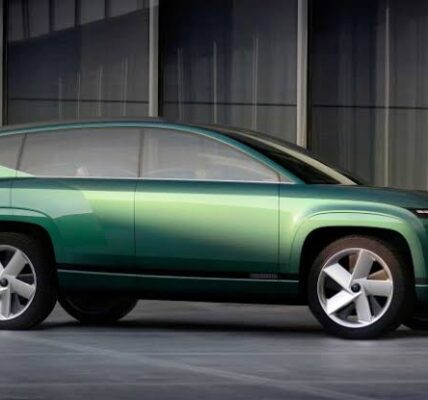Mazda on Friday revealed its rotary range-extended version of the MX-30 electric vehicle, called the Mazda MX-30 e-Skyactiv R-EV.
The MX-30 R-EV would offer a range far greater than the 100 EPA miles of the MX-30 EV, which is currently only offered in California. But as Mazda USA suggested earlier in the week, the R-EV that was previously confirmed for the U.S. may now be delayed or canceled entirely.
The R-EV is almost indistinguishable from the MX-30 EV except for some trim differences. That means you get the same rather eccentric package—a compact crossover with a somewhat more rakish roofline and two smaller rear-hinged rear doors. Bottom line: the MX-30 has essentially the same overall dimensions as the CX-30 crossover, but it doesn’t result in nearly as much usable passenger space.
Instead of the 35.5-kwh battery pack, the R-EV has a 17.8-kwh battery, enabling a 53-mile range by more generous European WLTC combined standards. Based on how other plug-in hybrids pencil in versus that European standard, that might mean a plug-in range of roughly 40 miles by U.S. EPA standards, although much of it depends on the test cycles themselves.
The Wankel rotary engine range-extender is a 0.83-liter unit—with a single rotor, as opposed to dual-rotor units in previous RX-8 and RX-7 sports cars—making just 73 hp and 86 lb-ft of torque. Its part-time job (and only job) is only to drive a generator. That pair fits under the hood with the electric motor, which makes 168 hp and 192 lb-ft of torque here—about 25 more hp but 18 fewer lb-ft than the MX-30 EV. Its official 0-62 mph time is 9.1 seconds
Mazda boasts that using a rotary rather than a reciprocating (piston) engine allows more compact packaging, and it saves weight. The engine’s side housing is made of aluminum rather than iron, Mazda says, which it claims cut more than 33 pounds. Overall, the R-EV weighs 3,912 pounds—257 pounds more than the EV’s curb weight.
Fuel efficiency has been atrocious in previous rotary designs, and tailpipe emissions have been challenging, which makes this engine design a puzzling choice from the outset; but Mazda says that direct fuel injection makes it more efficient. It’s also added exhaust gas recirculation (EGR) to help boost efficiency at low loads, and further evolved the design of the seals, which are a rotary-engine weak point.
Mazda says that the MX-30 delivers the same driving experience whether it’s running entirely off the battery pack or with the engine revving away. That’s different than the only other U.S.-market range-extended EV in recent years, the BMW i3 REx, which could sometimes be caught flat-footed and short on power for long highway grades, when its little two-cylinder range-extender under the cargo floor couldn’t keep up.
The Chevrolet Volt is sometimes called a range-extended electric vehicle, but Green Car Reports doesn’t consider it to be that, as the full-size gasoline engine drives the wheels at light cruising speeds.
Mazda says that one of the reasons behind this configuration is to extend driving range for long trips, and despite that and a decent roundup of the car’s specs it said nothing about the MX-30 R-EV’s efficiency in range-extender mode—or its highway range.
The 13.2-gallon gas tank is nothing like the little sub-2-gallon tank used in the BMW i3 REx, so considering a full charge and a full tank, the RE-V will likely offer all the range of a gasoline vehicle. And really, what’s to stop drivers from doing just that?
The answer might potentially be that, like the i3 REx, it’s just a more pleasant car to drive with the engine off. The little rotary needs to be revving at 4,700 rpm to be making peak power. The strident sound of a rotary engine when it’s revved is enchanting, but any owner of RX-8 or RX-7 sports cars can attest that rotaries tend not to be so endearing on long road trips.
There also appears to be a gray area in which the engine will start up even with a charge—a serious issue for anyone expecting a true EV driving experience in cities.
Mazda says that in EV mode, the R-EV will exclusively use electric drive “until the gauges show the battery is completely drained.” It also notes, even in EV mode: “Additionally, in situations such as if the driver needs to accelerate suddenly and purposefully depresses the accelerator pedal significantly beyond a certain point (equivalent to the kickdown switch function on a standard automatic transmission vehicle), the rotary engine generator will activate and generate the energy for the required output.”
In Normal mode, Mazda says that the rotary engine will fire up more often, based on how far you press the accelerator. Separately, there’s also a Charge mode that can save away charge so owners can drive quietly in EV mode or later use the car to power devices. Owners can set how much they’d like to charge up to, in 10% increments.
Using the MX-30 R-EV’s 7.2-kw onboard charger—more than the 6.6-kw unit that comes with U.S. MX-30 EVs—can go from a 20% to 80% charge in about 90 minutes, according to Mazda. It’s unclear if that 20% charge is the bottom end for electric-only operation. It’s also one of the only such vehicles to have DC fast charging—which, in the R-EV’s case, runs up to 36 kw and allows a 20% to 80% charge in about 25 minutes.
The R-EV supports V2L and has a cargo-area outlet offering 1500 watts.
It will be rolled out first in an Edition R version that offers a design inspired by the rotary engine, Mazda says—with Rouge Metallic roof accents and black for the body and trim.
That includes unique wheels, plus several nods to the unique trochoid shape of the engine rotor’s movement, including on a logo that adds an orange accent “to convey the power required to generate energy,” Mazda says.
Mazda hasn’t yet confirmed the price for Europe, but it suggests that it doesn’t cost much, if any, more than the MX-30 EV. “Larger batteries are more expensive, so using one would result in a more expensive vehicle,” it states in provided product information. “Additionally, a life cycle assessment (LCA) perspective demands optimizing the battery capacity for the vehicle.”
Now that it’s outlined what it is and how the specs pencil out, it’s not only a head-scratcher Americans might not understand as they shop for vehicles, but a vehicle that Americans, literally, might not get.








